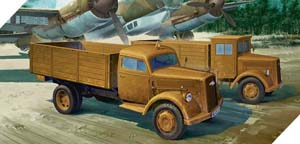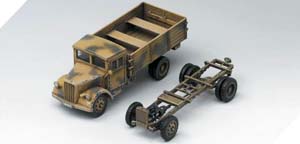| |
Academy WWII Ground Vehicle Set-5,
German Cargo Truck (Early & Late) (MRC13404)
by Frank De Sisto
1/72nd-scale injection-molded styrene kit containing 93 parts (including
13 clear), four decal/markings options and 12 pages of instructions in
17 steps. Price: $19.00 USD.

This latest kit from Academy, which is designed to compliment 1/72nd-scale
aircraft models, will also prove to be attractive to Braille scale AFV
and MV modelers. Particularly noteworthy is the option to build either
the standard enclosed metal cab, or the late-war “Einhiets”
cab made of non-strategic materials (press-board). The chassis is the
two-wheel-drive version.

There are several nice touches in this kit, a relatively major visual
error and one relatively major omission. First the nice stuff. The cab
(either version) contains shift levers, steering wheel, instrument panel
and bench seat (but no foot pedals), which is more than adequate for this
scale. There is a basic engine block and radiator for the area under the
hood and fairly complete chassis with undercarriage details. The designers
wisely chose not to impart any wood grain texture on the load-bed/cargo
compartment panels; this would have been overkill in this scale. All small
tools, vehicle jack, width indicator rods and Notek head-lamp are well
done, again considering the scale. The cabs both have separate clear sprues,
which include clear lenses for the head-lamps; only the windshield for
the “Einheits” cab has wiper blades molded on, there are none
on the windshield for the standard cab.
So far, so good. But, some things were overlooked by the kits designers.
There are no supports for the canvas tarp, which covered the cargo bed.
These were normally seen stored on the forward rim of the cargo compartment
and were quite visible. Some brass rod properly formed and strapped down
will fix this. There is no representation of the Notek tail-lamp system,
nor is any earlier style given. The tow point on the chassis rear needs
to be hollowed-out and have an “L”-shaped pin added. The radiator
grills for both cab designs have far too few slats and do not have the
small “Opel Blitz” insignia. All of these are relatively painless
fixes. But the biggest problem (both visually and accuracy-wise), and
also one that will be very difficult, if not impossible to correct is
the outer wheel/tire part for the dual rear wheels. It completely lacks
the scalloped cut-outs around the rim. You’re on your own here!
Overall, molding is crisp and details are well represented. There are
no ejector pin marks visible on the finished model, with the exception
of the load-bed underside. These are above the surface and will be easy
to remove without destroying nearby details. Notably, both sides of the
four cargo body panels are completely devoid of these pesky little guys.
The instructions are very clearly laid out and have very few operations
per step, something many will appreciate as it is less confusing. The
color schemes are generic, while the markings consist of Luftwaffe and
Heeres license plates as well as a vehicle shipping label for rail transport.
The color instructions are not keyed to available hobby paints, but merely
contain arrows with numbers, that in turn denote generic colors such as
“dark yellow” or “flat black”.
At $19.00 suggested US retail (and considering the listed errors and
omissions), this kit may not be as successful as the manufacturer and
the importers would desire. On the other hand, the cab options are a good
selling point and the modeler can probably get the kit at a discount by
shopping around.
Recommended with reservations.
Academy products are available from retail and mail-order shops. For
product details and more images, check their web site at: www.academyhobby.com.
|
|